Abstract
In recent years, with the development of hydrogen energy economy, there is an increasing demand for hydrogen in the market, and hydrogen production through biomass will provide an important way to supply clean, environmentally friendly and highly efficient hydrogen. In this study, cow dung was selected as the biomass source, and the efficiency of the biomass to hydrogen reaction was explored by coupling high temperature pyrolysis and water vapor gasification. The experimental conditions of gasification temperature, water mass fraction, heating rate and feed temperature were systematically studied and optimized to determine the optimal conditions for in situ hydrogen production by gasification of cow dung. The relationship of each factor to the yield of hydrogen production by gasification of cow dung semi-coke was investigated in order to elucidate the mechanism of the hydrogen production. The experiment determined the optimal operating parameters of in situ gasification: gasification temperature 1173 K, water mass fraction 80%, heating rate 10 K/min and feed temperature 673 K. The semi-coke treatment separated high temperature pyrolysis and water vapor gasification, and reduced the influence on gasification of volatile substances such as tar extracted from pyrolysis. The increase of semi-coke preparation temperature increases the content of coke, reduces the volatile matter and improves the yield of hydrogen; the small size of semi-coke particles and large specific surface area are beneficial to the gasification reaction.
1. Introduction
Hydrogen has advantages in many applications: it is clean, leads to environmental protection, has high efficiency, has many sources and it is suitable for energy storage. It is recognized as clean energy and is widely used in petroleum, chemical production, electronics, metallurgy, grease, aerospace, light industry and other fields. Its development and utilization can contribute to solving the energy crisis and environmental pollution problems, and it is regarded as one of the most promising clean energy sources in the 21st century. At present, hydrogen is mainly prepared by electrolysis of water, petrochemical energy and biomass. Hydrogen production from electrolytic water is less polluting to the environment, but the associated energy consumption is high, which is an obstacle at the economic level. Although the cost is lower, these production methods are based on fossil energy, which increases the consumption of fossil energy and generates large amounts of carbon emissions, so there is a limitation at the environmental level. Biomass hydrogen production systems can be divided into biomass hydrogen production and thermochemical processes. Biomass hydrogen production is a bioengineering technology that uses microbial metabolism to produce hydrogen, but the efficiency of microbial reactions are low and are not suitable for continuous flow and industrial production. Thermochemical processes include hydrogen production by gasification, pyrolysis reforming, and supercritical water conversion, etc. Biomass resources are widely distributed, rich in reserves, and are classified as renewable energy. The biomass to hydrogen process reduces the waste of resources and relieves the pressure on the environment and energy [1]. With the development of various hydrogen production technologies and processes, the development of fuel cell technology and the hydrogen energy economy will be greatly promoted. As more low-cost hydrogen production processes inevitably appear, there will be substantial economic benefits for related industries and also favorable conditions for the sustainable development of the country and society.
Biomass gasification hydrogen production technology has become one of the research hotspots in the field of hydrogen production due to its low cost, low pollution and high yield. Biomass gasification to hydrogen technology is the process of converting biomass into hydrogen-rich gas in a gasifying agent (air, water vapor, oxygen, etc.). The gasification agent component has a significant influence on the component distribution of the biomass gasification product, and water vapor gasification facilitates an increase in the H2 content of the gas [2]. The biomass gasification process has been intensively investigated worldwide in order to improve the effectiveness of gasification for hydrogen production [3]. Yong et al. developed a thermodynamics-based simulation model of the air-fruit string gasification process and investigated the effects of reactor temperature, heating medium concentration, steam/biomass ratio and system configuration on hydrogen concentration, calorific value, syngas ratio and cold gas efficiency, and concluded that steam gasification is more suitable for hydrogen production than air gasification [4]. Balu et al. studied the conversion of woody biomass into syngas using the steam pyrolysis gasification process, performed gasification experiments, and performed a gas chromatography analysis of the resulting syngas. The experimental results showed that the syngas produced by water vapor gasification had a high H2 concentration and a calorific value of 9–10 MJ/m3. A thermodynamic equilibrium was established for solid carbon deposition by varying the entering vapor temperature and vapor volume ratio in the thermochemical model [5]. Tian et al. explored the effect of biochemical composition (cellulose, hemicellulose and lignin) on syngas yield and chemical composition, and the experimental results showed that the gasification products of cellulose and hemicellulose were similar but different from those of lignin due to differences in volatile compounds; cellulose and hemicellulose gasify faster than lignin, produce more CO and CH4 and less H2 and CO2, and simulate the gasification characteristics of real biomass using a linear superposition method [6]. Many researchers have studied the biomass gasification for hydrogen production, mainly focusing on biomass semi-coke gasification. There are very few studies involving biomass in situ gasification. Therefore, it is necessary to analyze the biomass in situ gasification and semi-coke gasification process of cow manure.
This paper addresses the process of hydrogen preparation by gasification, and explores the optimal conditions for in situ gasification of cow manure for hydrogen production using water vapor evaporated from cow manure as the gasification agent. On this basis, the effect of a semi-coke treatment on gasification is investigated and the mechanism of hydrogen production by gasification of cow manure is elucidated to provide for the future development of hydrogen production technology based on biomass from livestock manure.
2. Experiment
2.1. Raw Materials
In this experiment, dried cow dung was used as the raw material for hydrogen production by gasification. The dung was harvested from Dongzheng Herding Co., Ltd. in Jiangxia District, Wuhan City, Hubei Province, and about 3 mm of dried cow dung was screened for use. The target preparation temperatures for the semi-coke preparation treatments were set at 573 K, 623 K, 673 K, 723 K, 773 K, 823 K and 873 K. The symbol BC-573 denotes the raw material for the semi-coke gasification preparation treatment at the preparation temperature of 573 K. Similarly, the symbols BC-623, BC-673, BC-723, BC-773, BC-823 and BC-873 are used to represent the raw materials of semi-coke treatment of cow dung at different preparation temperatures.
The semi-coke specimen was burned in pure oxygen and converted into CO2, H2O, N2 and SO2. The thermal conductivity of the gases was detected after separation through a chromatographic column, and the contents of C, H, N, and S in the specimen were determined. The contents of CO and other gases were also determined by pyrolysis in a He atmosphere. The CO was then separated and the oxygen content in the specimen was determined by thermal conductivity detection. Under conditions of specific atmosphere, temperature and time, the mass of the semi-coke specimen during the heating process was determined using far-infrared heating equipment and an electronic balance. The moisture, ash content, and volatile content in the specimen were then calculated. The results are shown in Table 1.

Table 1.
Elemental and industrial analysis results of semi-coked cow dung.
2.2. Basic Equipment
The experiment of hydrogen production from the pyrolysis of cow dung used a tube furnace as the reaction vessel. A T1200 three-stage tube furnace, manufactured by Zhengzhou Kejia Electric Furnace Co., Ltd. in the High-Tech Development Zone of Zhengzhou City, Henan Province, was chosen as the apparatus for heating. The apparatus included a power supply heating system, an anti-static system, a reactor, a condensation system, a gas collection system and a measurement system. The quartz tube in the tube furnace was 1800 mm long, with an external diameter of 120 mm and a wall thickness of 4 mm, and was sealed at both ends of the tube opening with stainless steel flanges. The three-stage tube furnace had three temperature zones with three temperature sensors to monitor and control the internal temperature of the quartz tube in real time, allowing different temperature conditions to be set for the heating of moist cow dung. The gases produced by the pyrolysis of cow dung in the quartz tubes were measured and recorded under a nitrogen-filled atmosphere using a Testo 350 flue gas analyzer manufactured by Beijing Filbert Environmental Technology Co. The flue gas detection analyzer can analyze and detect H2, H2O, O2, CO, CO2, NO, NO2, NOX, SO2, CXHY, flue gas, flue gas temperature, flue gas pressure, flue gas combustion efficiency and excess air coefficient in real time. By selecting differential pressure, flow rate and total emissions, the analyzer can detect H2S, H2, HCl, NH3 and other flue gas components after adding sensors.
Based on the experimental flow of in situ gasification to hydrogen, a water vapor emission device was added between the nitrogen cylinder and the three-stage tube furnace to create the experimental flow design of cow dung semi-coke gasification to hydrogen, as shown in Figure 1.
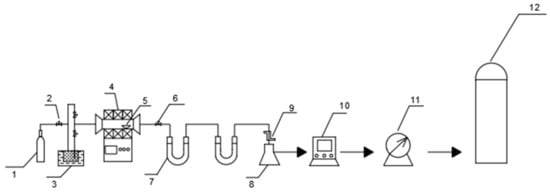
Figure 1.
Cow dung semi-coke gasification apparatus. 1, nitrogen bottle; 2, inlet valve; 3, steam generator; 4, three-stage tubular furnace; 5, porcelain cup; 6, outlet valve; 7, desiccant; 8, condensate pipe; 9, conical bottle; 10, flue gas analyzer; 11, pressure pump; 12, gas storage tank.
2.3. Scheme and Steps
For each experiment, 10.0 g of dried cow dung was placed in a porcelain cup. According to the different moisture treatments, the corresponding amount pure water was weighed and added to the porcelain cup and stirred evenly. Before the in situ gasification experiments were carried out, 99.99% nitrogen was introduced into the tube furnace through the gas inlet to remove the air from the quartz tube. The pressure of the incoming nitrogen was set at 0.5 MPa, and the interface of the tubular furnace was brushed using soapy water. When the feed temperature was reached, the wet cow dung was quickly added to the porcelain cup. The heating rate and end temperature of the tubular furnace were then set, and the end temperature was maintained for 20 min. After the experiment, the nitrogen was continuously added to ensure that all the pyrolysis gases in the tube were collected by the flue gas analyzer. When the temperature in the tube returned to room temperature, the experimental conditions and procedure were changed and repeated [7,8,9]. In order to reduce the experimental error, three measurements were taken. Their average value was taken as the final result, and the standard error was calculated.
The effects of four factors on the hydrogen production rate of in situ gasification of cow dung were studied: gasification temperature, water mass fraction, heating rate, and feed temperature, as shown in Table 2. The optimum experimental parameters of in situ gasification of cow dung for hydrogen production were obtained by an orthogonal experiment. Based on the optimal parameters of in situ gasification hydrogen production, the steam generator was introduced, and the corresponding required parameters were set. When the target temperature was reached, a steady steam flow was fed into the tubular furnace for 30 min under heating conditions.

Table 2.
Factor levels.
3. Experimental Results and Discussion
3.1. In Situ Gasification of Cow Dung for Hydrogen Production
3.1.1. Optimum Experimental Parameters

Table 3.
Orthogonal experimental scheme and results.

Table 4.
Analysis of in situ hydrogen production results.
The optimum process parameters for the hydrogen yield were determined by comparing the extreme differences of the four factors as A4, B4, D1 and C1; that is, gasification temperature 1173 K, water mass fraction 80%, heating rate 5 K/min and feed temperature 673 K. The main factors affecting the hydrogen yield were the gasification temperature and water mass fraction.
- (1)
- Effect of gasification temperature on the gasification process of cow dung
The main factor influencing the gasification process of cow dung was the gasification temperature. Increasing the gasification temperature was conducive to the gasification reaction and to increasing the hydrogen yield. Because in situ gasification of biomass for hydrogen production is a endothermic reaction, intermediate products from the pyrolytic gasification of cow dung, such as volatile substances including tar, are cracked at higher temperatures and reformed with water vapor to increase the hydrogen content in the gas [10].
- (2)
- Effect of water mass fraction on the gasification process
Moisture mass fraction and hydrogen yield were positively correlated; with the increase of the moisture mass fraction, the hydrogen yield increased continuously. The water vapor yield of the pyrolysis process increased as the moisture mass fraction increased. The water vapor produced reacts with the pyrolysis product carbon at high temperatures to produce carbon monoxide and hydrogen, while carbon monoxide reacts with water to produce carbon dioxide and hydrogen, so the increase in moisture mass fraction is beneficial to the increase in gas yield and hydrogen yield [11].
3.1.2. Mechanistic Analysis of In Situ Gasification
The process of gasification of cow dung is extremely complex and can be divided into three general stages: a heated dehydration and drying stage, a high temperature pyrolysis carbon stage and a hydrogen production stage by gasification of the pyrolysis products with water vapor [12]. These three stages occur sequentially but not independently of each other in the in situ gasification of cow dung experiments, and the reactions overlap with each other. The main reactions are as follows:
When the temperature begins to rise, the water on the surface of the cow dung evaporates and exists in the form of water vapor. When the temperature reaches 473 K, the pyrolysis reaction of cow dung begins, and hydrocarbons, tar and coke are continuously generated. The reaction occurs according to (1). When the temperature further rises to 773 K, the pyrolysis reaction rate continues to accelerate. At this time, the coke gasifies with steam to produce hydrogen and carbon oxygen compounds, and the reaction occurs according to (2) and (3). With the further increase in temperature, coke reacts with hydrogen to generate methane gas, as shown in Formula (4). The cow dung pyrolysis and steam gasification reactions overlap, and pyrolysis products and gasification intermediate products react with water vapor in complex physical and chemical reactions, as shown in Formulas (5)–(7). The content of hydrocarbons decreases and the output of hydrogen increases. When the temperature rises to 1073 K, the in situ gasification of cow dung is more complete, and the hydrogen production reaches the maximum level [13,14,15].
According to the above analysis, the hydrogen rich gas produced by cow dung gasification comes from two processes: one is the pyrolysis reaction in cow dung, and the second is the steam reforming reaction. The reforming reaction of cow dung pyrolysis products with steam is the main source of hydrogen.
During the in situ gasification of cow dung at a constant rate of temperature increase to the target temperature, the cow dung pattern exhibits different gasification characteristics at different temperatures, which are non-isothermal reactions [16]. The mathematical model for the gasification reaction of cow dung under non-isothermal conditions is [17,18]:
where x is the conversion rate, A is a pre-exponential factor, λ is a heating rate constant, E is the apparent activation energy, R is a gas constant, T is the reaction temperature, and f(x) is the differential form of the reaction function.
Integrating the f(x) reaction function gives the integral form G(x) as:
The 3D model function equation for the integral form of the reaction function, G(x), is [19]:
The experiment shows that the conversion rate of cow dung x is greater than 0.4. In Equation (10), when the conversion rate x is between 0 and 0.4, the value of the integral equation of the reaction function G(x) is small and does not meet the actual value of the study. When the conversion rate x is between 0.4 and 0.8, the integral equation of the reaction function G(x) is fitted and approximated as G(x) = 0.25x, as shown in Figure 2.
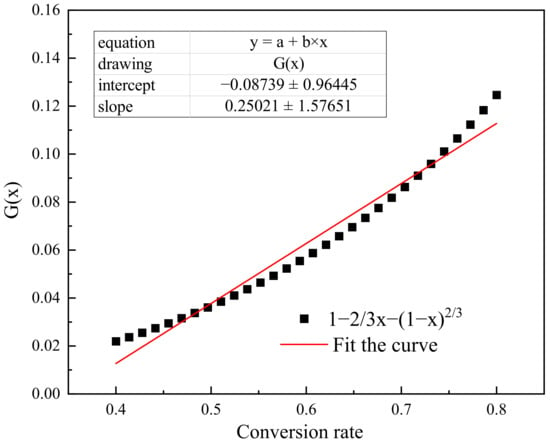
Figure 2.
Fitting equation for the integral equation of the reaction function G(x).
When the water content is μ, the theoretical hydrogen yield is 1200μ mL/g, and the relationship for the actual hydrogen yield φ1 generated is:
There are problems affecting the hydrogen yield in the process of in situ gasification to produce hydrogen: (1) To obtain a higher hydrogen yield, the retention time of the gas in the three-stage tube furnace is extended. The longer the gas stays in the tube furnace, the higher the gas tightness requirements for the whole plant and the longer the production cycle, which raises the production costs and is not conducive to continuous industrial production. (2) The process of in situ gasification does not separate pyrolysis and gasification, and the pyrolysis process produces pyrolysis gas accompanied by tar, which hinders the further utilization of the pyrolysis gas. In order to ensure the quality of the pyrolysis gas and protect the reaction equipment, and to improve the reuse efficiency of cow dung biomass energy, the preparation of hydrogen-containing gas from cow dung semi-coke was chosen to solve the above problems by reducing the tar content in the pyrolysis gas, reducing the energy required to produce hydrogen and save experimental costs [20,21].
3.2. Hydrogen Production from Semi-Coke Gasification of Cow Dung
3.2.1. Hydrogen Yield from Semi-Coke Gasification
As shown in Table 5 and Figure 3, the effect of the semi-coke treatment on the gasification process was significantly enhanced by the cow manure, and different preparation temperatures and particle diameters had an effect on the experimental results. As the preparation temperature increased, the hydrogen yield gradually increased. At preparation temperatures above 773 K, a small decrease in hydrogen yield occurred. The difference between the results of BC-773 and BC-873 was not significant, so the preparation temperature of 773 K was chosen as the preferred temperature in consideration of the cost and energy consumption of the experiments. This is because the semi-coke process improves the reaction conditions of the secondary cracking and reforming reactions, reduces the volatile content and carbon content of cow dung, and because the semi-coke treatment facilitates the rapid reforming reaction of water vapor. The small size of the semi-coke particles, the large specific surface area and the high reaction efficiency of the contact with the water vapor stream facilitate the semi-coke gasification reaction and increase the hydrogen yield [22].

Table 5.
Hydrogen yield from semi-coke gasification.
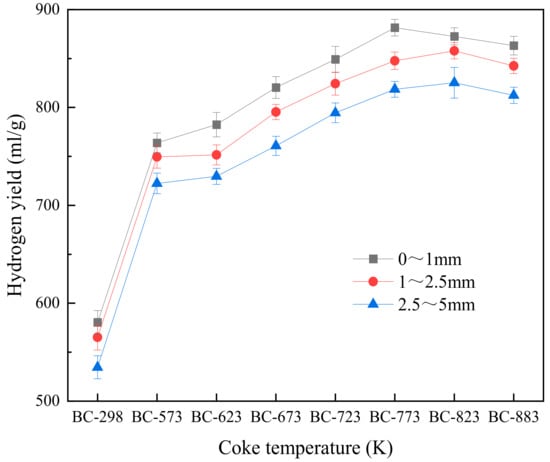
Figure 3.
Hydrogen yield from semi-coke gasification.
3.2.2. Mechanism of Hydrogen Production by Gasification of Cow Dung
The biomass gasification process has two main components: biomass pyrolysis and water vapor gasification. Pyrolysis is the process of releasing volatile fractions from biomass at a certain temperature. When the pyrolysis is sufficient and all volatile components are released from the raw material, the residual biochar is mainly fixed carbon and ash. When the pyrolysis temperature does not meet the conditions, the volatile fraction is not completely released from the feedstock and the remaining unprecipitated volatile fraction remains in the fixed carbon. This biomass that still contains the volatile fraction is called semi-coke. Semi-coke gasification is the separation of the two stages of pyrolysis and water vapor gasification at high temperatures, which reduces the impact on the gasification of volatile substances such as tar from the thermal resolution of cow dung. The manure is first pretreated and dried then pyrolyzed at high temperature to form semi-coke, and finally gasified in the presence of a stream of water vapor [14].
Compared with the in situ gasification process, the experimental unit for the semi-coke gasification process does not have to be as gas-tight, which helps to improve the safety of the entire experimental process. In the semi-coke process, cow dung is pre-treated and gasified at high temperatures in a tube furnace, separating the charring and gasification products of the dung to facilitate the reforming reaction without affecting the secondary cracking of the volatile fraction. The C content increases and the O content decreases after the semi-coke treatment, resulting in a rapid increase in the C/O ratio, as shown in Figure 4. The fitted curve for the semi-focused elemental C content γC versus the preparation temperature T1 is: γC = 4.7 × 10−4T1 + 0.32, as shown in Figure 5. The process of preparing hydrogen-containing gas from semi-coke effectively reduces the volatile content of cow dung and increases the solid carbon content, facilitating the water vapor reforming reaction, while the pyrolysis process allows for sufficient secondary cracking of the tar to facilitate hydrogen production.
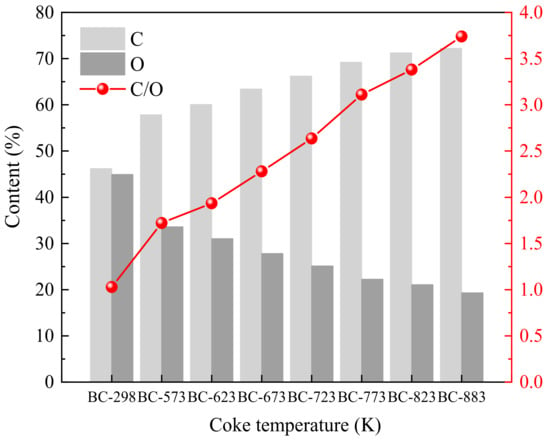
Figure 4.
C, O and C/O content of semi-focal elements.
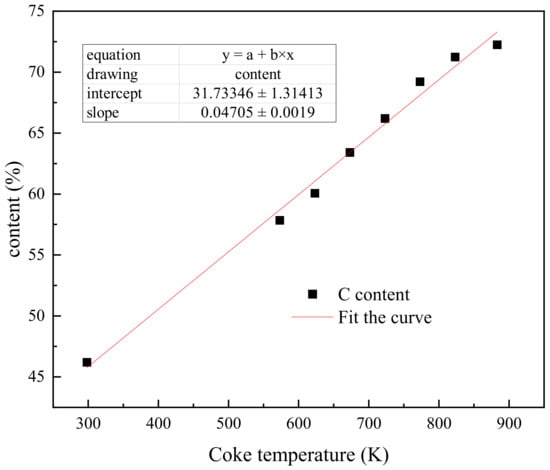
Figure 5.
Fitted curve of semi-focused elemental C content versus temperature.
During the experimental isothermal reaction of cow dung semi-coke gasification, the unreacted nucleus model theory of the gas-solid reaction was used to investigate the cow dung gasification reaction process in order to simplify the study. During the cow dung semi-coke gasification reaction, the process from the entry of water vapor into the tube furnace in contact with the cow dung to the generation of hydrogen occurs through the following processes: the diffusion of the gas in the boundary layer within the gas phase; the diffusion of the gas in the reduced layer within the solid phase; the interfacial chemical reaction; the diffusion of the gas products outwards within the solid phase; and the diffusion of the gas products outwards within the gas phase. When the flow rate of water vapor remains stable, the rate of diffusion of the gas within the gas phase is rapid, i.e., the limiting link of the reaction process consists of diffusion of the gas within the solid phase and interfacial chemical reactions. The rate expressions for each link are [23]:
where Q are the interfacial chemical reaction rates, K are reaction equilibrium constants, c1 is the concentration at the reaction interface, and c2 is the equilibrium concentration of the reactant gas.
In Equation (13), Φ is the diffusion rate of gases within the product layer, De is the effective diffusion coefficient, r is the radius of the reaction boundary layer from the center of the particle sphere, r0 is the radius of cattle manure pellets, and c0 is the initial concentration of gas.
The greater the difference in gas concentration, the greater the diffusion flux. Since r cannot be measured, the degree of gasification λ needs to be defined:
When the gasification reaction reaches steady state, the reaction rates are equal in all steps and the overall reaction rate ν is [24]:
For an individual cow dung pellet, water vapor diffuses inwards through the surface of the pellet and undergoes a gasification reaction with it. The gasification reaction rate ν is expressed as:
Let Equations (15) and (16) be equal, and integrate the two sides of the equation to simplify:
where .
The hydrogen yield φ2 prepared by semi-coke gasification is:
where γC is the elemental C content of the semi-coke, and T1 is the semi-coke preparation temperature.
4. Conclusions
In the current paper, two processes were investigated: in situ gasification of cow dung and semi-coke gasification to produce hydrogen. On the basis of the orthogonal test, the optimal experimental parameters for the in situ gasification of cow dung were determined. This provides reference data and theoretical basis for the large-scale production of hydrogen from cow dung gasification. The main conclusions are as follows:
- (1)
- The optimum process parameters for in situ gasification of cow manure are: gasification temperature 1173 K, water mass fraction 80%, heating rate 5 K/min, and feed temperature 673 K. The main factors affecting the hydrogen yield are gasification temperature and water mass fraction, and the hydrogen yield from in-situ gasification of cow manure is:
- (2)
- The high temperature and small particle size of the semi-coke cow dung preparation facilitates the gasification reaction and increases the hydrogen yield. The hydrogen yield φ2 prepared by semi-coke gasification is:
where .
- (3)
- The semi-coking treatment separates the pyrolysis of cow dung from the water vapor gasification. This reduces the inhibition of the gasification reaction by volatile substances, improves the reaction conditions for the secondary cracking and reforming reactions, and increases the coke content in the cow dung. These effects are conducive to the water vapor gasification reaction and increasing the hydrogen production.
Author Contributions
Conceptualization, H.L. and Q.X.; methodology, Q.X.; software, J.H. and Z.W.; validation, G.Z., H.L. and Q.X.; formal analysis, G.Z.; investigation, H.L.; resources, Q.X.; data curation, G.Z.; writing—original draft preparation, G.Z.; writing—review and editing, H.L.; visualization, G.Z.; supervision, H.L.; project administration, Q.X.; funding acquisition, Q.X. All authors have read and agreed to the published version of the manuscript.
Funding
This work was supported by National Natural Science Foundation of China-Xinjiang Joint Fund (U2003124), National Natural Science Foundation of China (No. 51974001), the University outstanding young talents funding program (No. gxyq2019016), and the Open Fund of the State Key Laboratory of New Technology of Iron and Steel Metallurgy (KF21-03).
Institutional Review Board Statement
Not applicable.
Data Availability Statement
Not applicable.
Conflicts of Interest
The authors declare that they have no known competing financial interests or personal relationships that could have appeared to influence the work reported in this paper.
References
- Chang, A.C.; Chang, H.F.; Lin, F.J.; Lin, K.H.; Chen, C.H. Biomass gasification for hydrogen production. Int. J. Hydrogen Energy 2011, 36, 14252–14260. [Google Scholar] [CrossRef]
- Gautam, G.; Adhikari, S.; Bhavnani, S. Estimation of biomass synthesis gas composition using equilibrium modeling. Energy Fuels 2010, 24, 2692–2698. [Google Scholar] [CrossRef]
- Samimi, F.; Marzoughi, T.; Rahimpour, M.R. Energy and exergy analysis and optimization of biomass gasification process for hydrogen production (based on air, steam and air/steam gasifying agents). Int. J. Hydrogen Energy 2020, 45, 33185–33197. [Google Scholar] [CrossRef]
- Yong, Y.S.; Rasid, R.A. Process simulation of hydrogen production through biomass gasification: Introduction of torrefaction pre-treatment. Int. J. Hydrogen Energy 2021. [Google Scholar] [CrossRef]
- Balu, E.; Lee, U.; Chung, J.N. High temperature steam gasification of woody biomass–a combined experimental and mathematical modeling approach. Int. J. Hydrogen Energy 2015, 40, 14104–14115. [Google Scholar] [CrossRef]
- Tian, T.; Li, Q.; He, R.; Tan, Z.; Zhang, Y. Effects of biochemical composition on hydrogen production by biomass gasification. Int. J. Hydrogen Energy 2017, 42, 19723–19732. [Google Scholar] [CrossRef]
- Corella, J.; Toledo, J.M.; Molina, G. Biomass gasification with pure steam in fluidized bed: 12 variables that affect the effectiveness of the biomass gasifier. Int. J. Oil Gas Coal Technol. 2008, 1, 194–207. [Google Scholar] [CrossRef]
- Xu, C.C.; Donald, J.; Byambajav, E.; Ohtsuka, Y. Recent advances in catalysts for hot-gas removal of tar and NH3 from biomass gasification. Fuel 2010, 89, 1784–1795. [Google Scholar] [CrossRef]
- Cohce, M.K.; Rosen, M.A.; Dincer, I. Efficiency evaluation of a biomass gasification-based hydrogen production. Int. J. Hydrogen Energy 2011, 36, 11388–11398. [Google Scholar] [CrossRef]
- Song, G.; Chen, L.; Xiao, J.; Shen, L. Exergy evaluation of biomass steam gasification via interconnected fluidized beds. Int. J. Energy Res. 2013, 37, 1743–1751. [Google Scholar] [CrossRef]
- Kırtay, E. Recent advances in production of hydrogen from biomass. Energy Convers. Manag. 2011, 52, 1778–1789. [Google Scholar] [CrossRef]
- Khorasani, R.; Khodaparasti, M.S.; Tavakoli, O. Hydrogen production from dairy wastewater using catalytic supercritical water gasification: Mechanism and reaction pathway. Int. J. Hydrogen Energy 2021, 46, 22368–22384. [Google Scholar] [CrossRef]
- Xin, Y.; Cao, H.; Yuan, Q.; Wang, D. Two-step gasification of cattle manure for hydrogen-rich gas production: Effect of biochar preparation temperature and gasification temperature. Waste Manag. 2017, 68, 618–625. [Google Scholar] [CrossRef]
- Wan, W.; Dai, Z.; Li, C.; Yu, G.; Wang, F. Innovative concept for gasification for hydrogen based on the heat integration between water gas shift unit and coal-water-slurry gasification unit. Int. J. Hydrogen Energy 2014, 39, 7811–7818. [Google Scholar] [CrossRef]
- Straka, P.; Bičáková, O. Hydrogen-rich gas as a product of two-stage co-gasification of lignite/waste plastics mixtures. Int. J. Hydrogen Energy 2014, 39, 10987–10995. [Google Scholar] [CrossRef]
- Yu, L.; Zhang, R.; Cao, C.; Liu, L.; Fang, J.; Jin, H. Hydrogen production from supercritical water gasification of lignin catalyzed by Ni supported on various zeolites. Fuel 2022, 319, 123744. [Google Scholar] [CrossRef]
- Burnham, A.K.; Braun, R.L. Global kinetic analysis of complex materials. Energy Fuels 1999, 13, 1–22. [Google Scholar] [CrossRef]
- Alonso, M.; Alvarez, D.; Borrego, A.; Menédez, R.; Marban, G. Systematic effects of coal rank and type on the kinetic of coal pyrolysis. Energy Fuels 2001, 15, 413–428. [Google Scholar] [CrossRef]
- Mao, Y.; Dong, L.; Dong, Y.; Liu, W.; Chang, J.; Yang, S.; Lv, Z.; Fan, P. Fast co-pyrolysis of biomass and lignite in a micro fluidized bed reactor analyzer. Bioresour. Technol. 2015, 181, 155–162. [Google Scholar] [CrossRef]
- Moghtaderi, B. Effects of controlling parameters on production of hydrogen by catalytic steam gasification of biomass at low temperatures. Fuel 2007, 86, 2422–2430. [Google Scholar] [CrossRef]
- Hao, X.; Guo, L.; Zhang, X.; Guan, Y. Hydrogen production from catalytic gasification of cellulose in supercritical water. Chem. Eng. J. 2005, 110, 57–65. [Google Scholar] [CrossRef]
- Zhang, R.; Cummer, K.; Suby, A.; Brown, R.C. Biomass-derived hydrogen from an air-blown gasifier. Fuel Process. Technol. 2005, 86, 861–874. [Google Scholar] [CrossRef]
- Homma, S.; Ogata, S.; Koga, J.; Matsumoto, S. Gas–solid reaction model for a shrinking spherical particle with unreacted shrinking core. Chem. Eng. Sci. 2005, 60, 4971–4980. [Google Scholar] [CrossRef]
- Kawamata, Y.; Yoshikawa, T.; Aoki, H.; Koyama, Y.; Nakasaka, Y.; Yoshida, M.; Masuda, T. Kinetic analysis of delignification of cedar wood during organosolv treatment with a two-phase solvent using the unreacted-core model. Chem. Eng. J. 2019, 368, 71–78. [Google Scholar] [CrossRef]
Publisher’s Note: MDPI stays neutral with regard to jurisdictional claims in published maps and institutional affiliations. |
© 2022 by the authors. Licensee MDPI, Basel, Switzerland. This article is an open access article distributed under the terms and conditions of the Creative Commons Attribution (CC BY) license (https://creativecommons.org/licenses/by/4.0/).